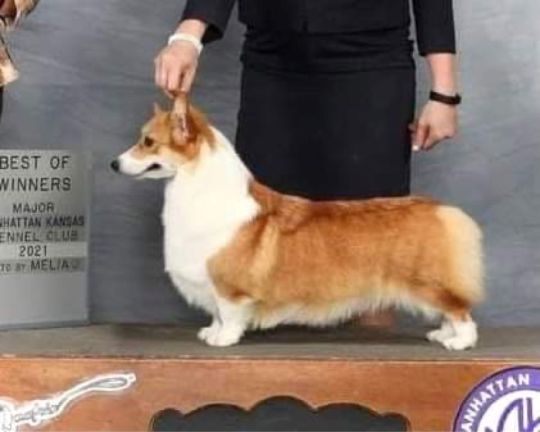I have a friend that helps me with the facts (bear) so yeah. Wellllllll enjoy and I really hope this helped!
Don't wanna be here? Send us removal request.
Text

Corgi
Viewed from above, the body should taper slightly to end of loin. Loin short. Round or flat rib cage, lack of brisket, extreme length or cobbiness, are undesirable. Tail - Docked as short as possible without being indented. Occasionally a puppy is born with a natural dock, which if sufficiently short, is acceptable. A tail up to two inches in length is allowed, but if carried high tends to spoil the contour of the topline.
Forequarters: Legs - Short, forearms turned slightly inward, with the distance between wrists less than between the shoulder joints, so that the front does not appear absolutely straight. Ample bone carried right down into the feet. Pasterns firm and nearly straight when viewed from the side. Weak pasterns and knuckling over are serious faults.
Shoulder blades long and well laid back along the rib cage. Upper arms nearly equal in length to shoulder blades. Elbows parallel to the body, not prominent, and well set back to allow a line perpendicular to the ground to be drawn from tip of the shoulder blade through to elbow. Feet - Oval, with the two center toes slightly in advance of the two outer ones. Turning neither in nor out. Pads strong and feet arched. Nails short. Dewclaws on both forelegs and hindlegs usually removed. Too round, long and narrow, or splayed feet are faulty.
Hindquarters: Ample bone, strong and flexible, moderately angulated at stifle and hock. Exaggerated angulation is as faulty as too little. Thighs should be well muscled. Hocks short, parallel, and when viewed from the side are perpendicular to the ground. Barrel hocks or cowhocks are most objectionable. Slipped or double-jointed hocks are very faulty.
Coat: Medium length; short, thick, weather- resistant undercoat with a coarser, longer outer coat. Over-all length varies, with slightly thicker and longer ruff around the neck, chest and on the shoulders. The body coat lies flat. Hair is slightly longer on back of forelegs and underparts and somewhat fuller and longer on rear of hindquarters. The coat is preferably straight, but some waviness is permitted. This breed has a shedding coat, and seasonal lack of undercoat should not be too severely penalized, providing the hair is glossy, healthy and well groomed
COLORS
DESCRIPTION STANDARD COLOR REGISTRATION CODE
Black & Tan 018
Fawn 082
Red 140
Sable 164
Health
The Pembroke is typically a healthy breed, and responsible breeders screen their stock for health conditions such as elbow and hip dysplasia, eye disorders, cardiac issues, degenerative myelopathy, and von Willebrand’s disease, a bleeding disorder. As with all breeds, a Pembroke’s ears should be checked weekly for signs of infection, and the teeth should be brushed regularly.
Recommended Health Tests From the National Breed Club:
* Hip Evaluation
* Ophthalmologist Evaluation
0 notes
Text
BITEWORK
(read my bio!)
Looking for a trainer in bite sports can be an exciting and rewarding process. Here are some steps to help you find the right trainer:
1. Research local bite sports clubs or organizations: Start by researching local bite sports clubs or organizations in your area. These clubs often have experienced trainers who specialize in bite sports such as Schutzhund, French Ring, or Mondioring. Look for clubs that have a good reputation and a track record of success.
2. Attend training sessions and competitions: Visit training sessions and competitions organized by these clubs to observe different trainers in action. This will give you an opportunity to see how they work with dogs and interact with their clients. Take note of their training techniques, communication skills, and overall training philosophy.
3. Seek recommendations and referrals: Talk to other bite sports enthusiasts, trainers, or dog owners involved in bite sports. Ask for recommendations and referrals to trainers they trust and have had positive experiences with. Personal recommendations can be valuable in finding a reliable and competent trainer.
have shortlisted a few potential trainers, arrange to meet them for an interview or consultation. Ask them about their experience, certifications, training methods, and philosophy. Inquire about their success rate and the achievements of their previous clients. Additionally, discuss your goals and expectations for training to ensure they align with the trainer’s approach.
5. Request to observe training sessions: If possible, ask if you can observe a training session conducted by the trainer. This will allow you to see their training style, how they handle dogs, and how they interact with their clients. It will also give you an opportunity to assess their teaching ability and communication skills.
Consider the trainer’s specialization and expertise: Bite sports encompass various disciplines, such as protection work, obedience, tracking, and more. Consider the specific area in which you want to train your dog and find a trainer who specializes in that particular discipline. A trainer with expertise in your chosen bite sport will have a better understanding of the skills and techniques required.
7. Evaluate the trainer’s connection with dogs: Pay attention to how the trainer interacts with dogs during training sessions. Look for trainers who display a genuine connection with the dogs, treat them with respect, and use positive reinforcement techniques. A good trainer should prioritize the welfare and well-being of the dogs they work with.
8. Assess the training environment: Evaluate the training environment and facilities provided by the trainer. Ensure that they have suitable equipment, training tools, and a safe and clean training area. Consider whether the location is convenient for you and whether the training schedule aligns with your availability.
9. Discuss fees and training plans: Finally, discuss the trainer’s fees and training plans. Ask about their rates, training packages, and any additional costs associated with training. Consider your budget and determine if the trainer’s fees are reasonable for the services they provide
1 note
·
View note
